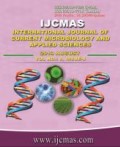


 National Academy of Agricultural Sciences (NAAS)
National Academy of Agricultural Sciences (NAAS)

|
PRINT ISSN : 2319-7692
Online ISSN : 2319-7706 Issues : 12 per year Publisher : Excellent Publishers Email : editorijcmas@gmail.com / submit@ijcmas.com Editor-in-chief: Dr.M.Prakash Index Copernicus ICV 2018: 95.39 NAAS RATING 2020: 5.38 |
Increase in animal population has resulted in rise in animal bite cases and thus increase the potential for transmission of zoonotic diseases. That is why it is very important to consider some factors while considering the likelihood of disease transmission which includes species of animal, type of injury, severity of injury, vaccination status, interval between incident and treatment, and various attributes of the injured person (age, underlying health, etc.). It is also important to have knowledge about the natural oral flora of the animal. As mouth cavity of animals is rich in microflora, which sets infection when inoculated in skin of victim. Most frequently isolated bacteria in animal bite other than Rabies are Pasturella spp., Streptococcus, Staphylococcus, Moraxella, Corynebacterium, Neisseria, Fusobacterium, Bacteroides, Posphuomonoa, Capnocytophagacanimorsus and Prevotella. But there is lack of understanding and a very few data is available on natural oral flora of animal, mechanism of animal bite and pathogenic significance of isolated organisms from bite wounds. Even though the available literature in this field if present mostly focused on case report of rabies, neglecting other diseases which are evenly fatal if untreated. Thus, in the present study, data from various sources has been summarized to emphasis on various infection other than rabies which are transmitted via animal bite including human and mechanism of animal bite. So that the infection cause by bite wound can be efficiently diagnose by a physician for its proper management.
 |
 |
 |
 |
 |